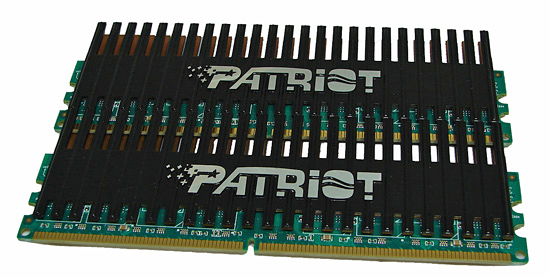Operating System
Both systems will be moving from XP to Vista. Some might consider that a downgrade of epic proportions, but I have grown fond of Vista 64-bit and even more fond of 4GB of memory utilized properly by the operation system. Setting up Windows 2008 Server in a workstation configuration crossed my mind as a way to utilize my MSDN subscription extras, but I decided in the end to just pop the Vista 64 install DVD in and go for it. For those who prefer Linux, I am not quite ready to use it 24/7 but one of these old platforms is now a dedicated Linux machine for my continuing educational needs.

Memory
The first item I went shopping for was memory. After spending the past few weeks testing multitudes of 2GB DDR2 modules, I concluded that I wanted a 2x2GB DDR2-800 CAS4 kit based on the best blend of price to performance in that category. Sure, CAS5 would more than suffice for our needs and most of the CAS5 modules could be coaxed into CAS4 operation with a bump in voltage or relaxing a couple of timings. However, having the security of plug in and forget about it was worth the extra couple of dollars for CAS4.
The next decision was which supplier to utilize. The easy choice would have been the companies we typically choose for our test bed components or those that have received great reviews from us or other reputable websites. To be honest, this was a difficult purchasing decision, made especially difficult after the testing we just completed. The choices and results clouded an already muddied mind, as there was not a bad kit in the bunch - certainly not one I would ever hesitate to purchase.
I let my budget constraints sway my search process but still ended up with a top-flight choice in the Patriot PVS24G6400LLK DDR2-800 CAS4 4GB kit. When I purchased the memory it was $74.99 for a 4GB kit with rebate, but I had to pay shipping costs so the current $79.99 price with free shipping is actually a better deal at Newegg. Considering both machines will have multiple browser windows, IM programs, and general office applications open at once along with a heavy dose of Photoshop, Dreamweaver, and Premiere Pro activities, I broke the bank and bought 8GB for each machine. Stretching the budget will become a common theme throughout my component selections. (It is also a reason why I will need to eBay my John Travolta signature 70's Disco clothing lineup now.)
I figure 8GB should be good for the next three years and solidifies my thought process that you can never have enough memory with a 64-bit operating system. Patriot recommends 2.2V for CAS4 operation at DDR2-800 with 4GB. I tested this memory on several boards and got away with 1.85V~1.90V with 4GB at 4-4-3-10 timings, well under the 4-4-4-12 2.2V recommendation. I had to increase VDimm to 2.0V and timings to 4-4-4-12 at DDR2-800 with an 8GB configuration on the boards I purchased. To say that I have been pleasantly surprised with this choice would be an understatement. As usual, your mileage will vary depending upon other components and usage patterns.
Power Supply
Next up is the power supply. This is a component that I look at as an investment since a quality power supply will last for several years and is extremely important in ensuring stable operation of your system. I take this purchasing decision seriously and balance system needs, acoustical considerations, and unit quality when determining what item to select. The power supplies I have in the current systems have served me well for the last five years, but they are no longer up to spec for the components going into the new systems.
That said, I do have a budget to adhere to so I was extremely surprised to see the PC Power & Cooling S610EPS Silencer marked down from $199 to $89.99 with rebate. The power requirements for our systems do not call for this type of wattage and a high quality 380W~430W unit would do just fine. However, for the extra few dollars (Ed: here we go again…) the lure of the S610 Silencer was just too much to resist, especially if a mid-life GPU upgrade requires additional power or these power supplies migrate to other systems. One caveat: this power supply is a little longer than normal and required a shoehorn to get it into our SG03 case.
Another power supply that deserves special mention and one I purchased this week for another article is the Silverstone ST50EF-SC 500W unit that Silverstone designed with this case and other SFF units in mind. The unit features shorter than normal cables so your SFF case is not as cluttered. The unit is very quiet, has an excellent efficiency rating, uses high quality components, and comes with dual six-pin PCI Express connectors for the same price as the S610EPS Silencer.










33 Comments
View All Comments
JarredWalton - Wednesday, May 28, 2008 - link
You might want to do a bit more http://en.wikipedia.org/wiki/MicroATX">research. Just as all ATX boards aren't identical in size, there is some leeway in how big a micro-ATX board can be. Maximum size is 9.6" x 9.6", but they can be much smaller than that as well.While the correct abbreviation is µATX, mATX and uATX are synonyms that are equally valid in our modern PC vernacular. (Gasp! You mean Newegg is wrong!? Yup. It happens. Or you could consider it a mere difference of opinion, where Newegg is trying to redefine uATX to mean something other than mATX.)
DXRick - Thursday, May 29, 2008 - link
Thanks. Sorry for being stupid.FireTech - Tuesday, May 27, 2008 - link
A very interesting 'article' Gary, with insight into the world of a reviewer but nicely balanced with the requirements of the typical cash conscious geek/husband/parent!I'm certainly looking forward to part two.